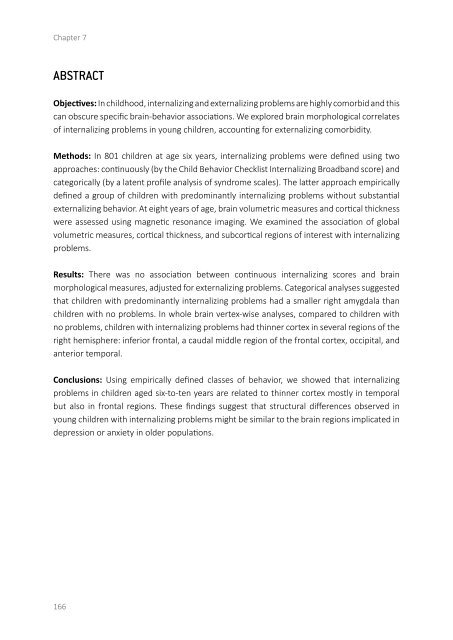On the Spectrum
2lm5UyR
2lm5UyR
Create successful ePaper yourself
Turn your PDF publications into a flip-book with our unique Google optimized e-Paper software.
Chapter 7<br />
ABSTRACT<br />
Objectives: In childhood, internalizing and externalizing problems are highly comorbid and this<br />
can obscure specific brain-behavior associations. We explored brain morphological correlates<br />
of internalizing problems in young children, accounting for externalizing comorbidity.<br />
Methods: In 801 children at age six years, internalizing problems were defined using two<br />
approaches: continuously (by <strong>the</strong> Child Behavior Checklist Internalizing Broadband score) and<br />
categorically (by a latent profile analysis of syndrome scales). The latter approach empirically<br />
defined a group of children with predominantly internalizing problems without substantial<br />
externalizing behavior. At eight years of age, brain volumetric measures and cortical thickness<br />
were assessed using magnetic resonance imaging. We examined <strong>the</strong> association of global<br />
volumetric measures, cortical thickness, and subcortical regions of interest with internalizing<br />
problems.<br />
Results: There was no association between continuous internalizing scores and brain<br />
morphological measures, adjusted for externalizing problems. Categorical analyses suggested<br />
that children with predominantly internalizing problems had a smaller right amygdala than<br />
children with no problems. In whole brain vertex-wise analyses, compared to children with<br />
no problems, children with internalizing problems had thinner cortex in several regions of <strong>the</strong><br />
right hemisphere: inferior frontal, a caudal middle region of <strong>the</strong> frontal cortex, occipital, and<br />
anterior temporal.<br />
Conclusions: Using empirically defined classes of behavior, we showed that internalizing<br />
problems in children aged six-to-ten years are related to thinner cortex mostly in temporal<br />
but also in frontal regions. These findings suggest that structural differences observed in<br />
young children with internalizing problems might be similar to <strong>the</strong> brain regions implicated in<br />
depression or anxiety in older populations.<br />
166


